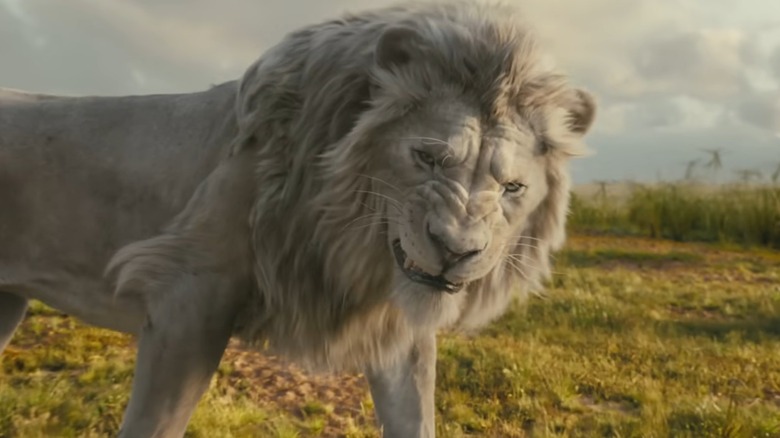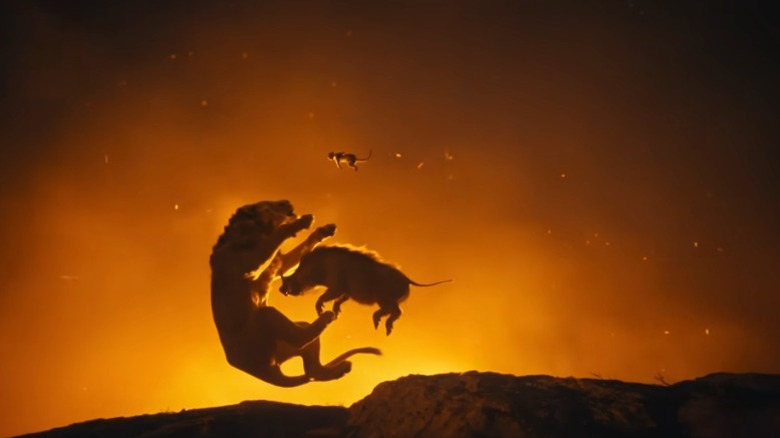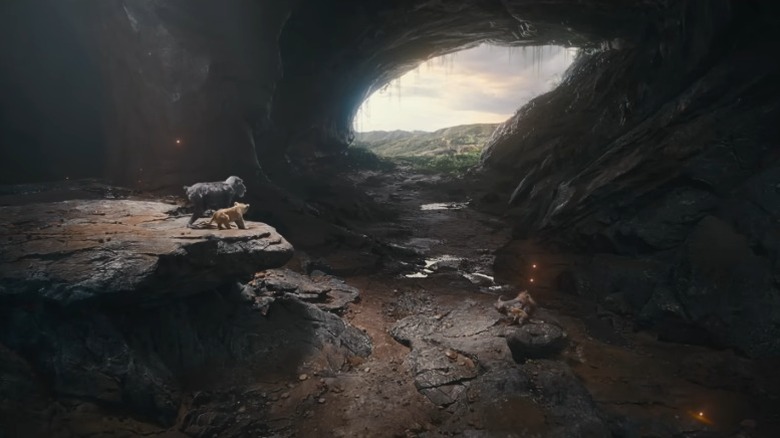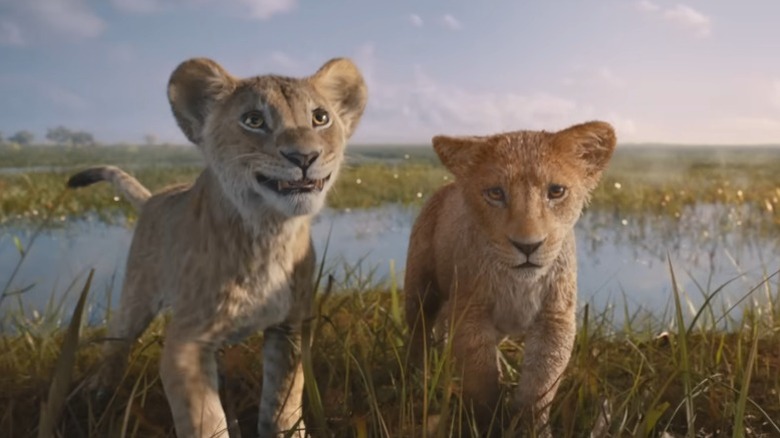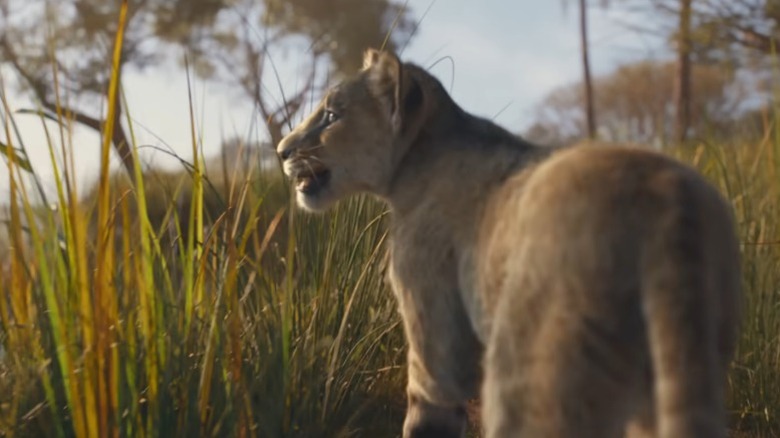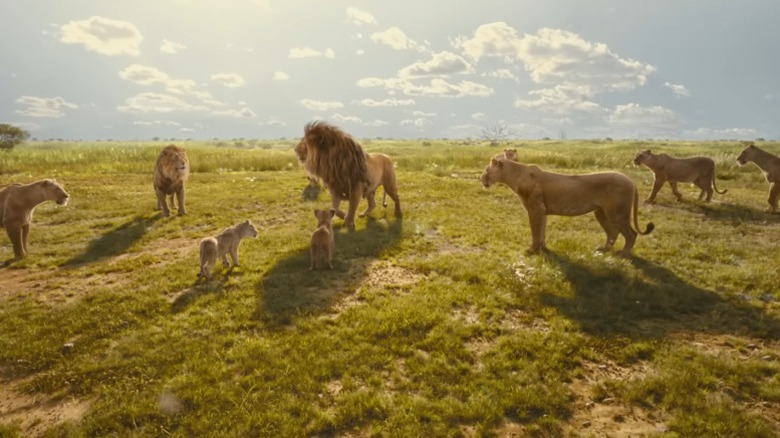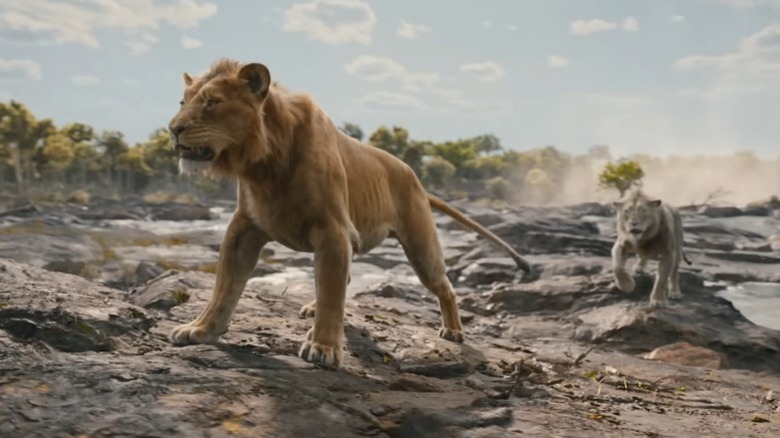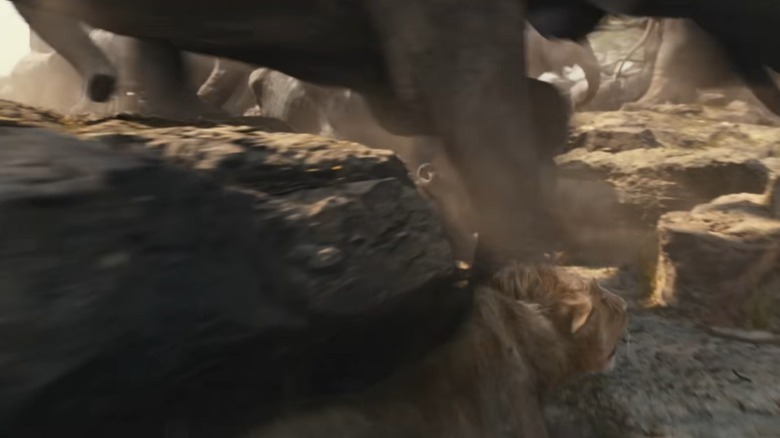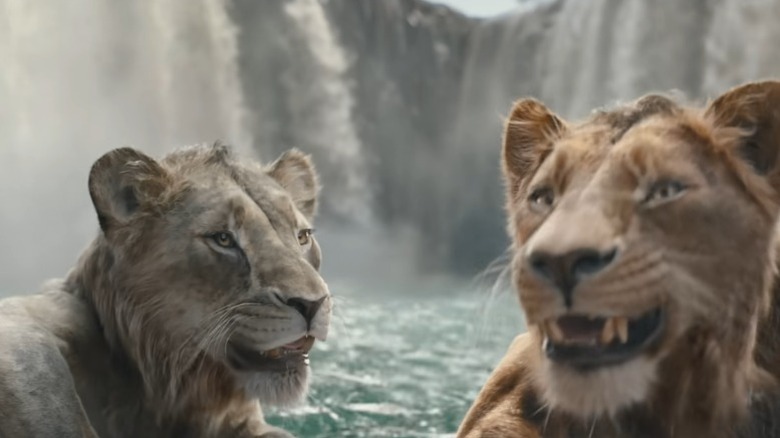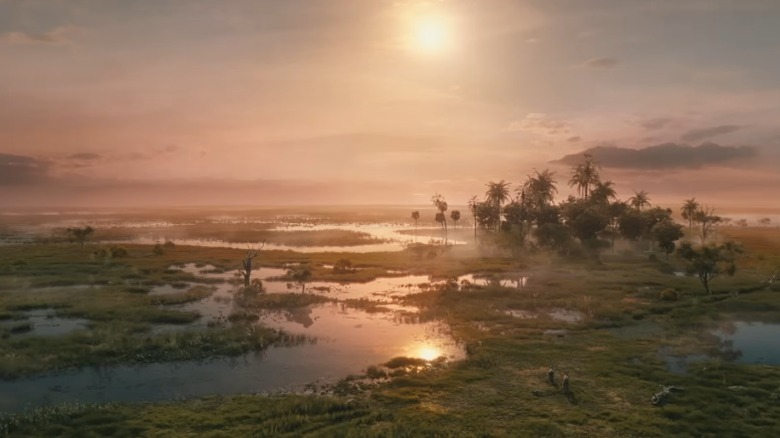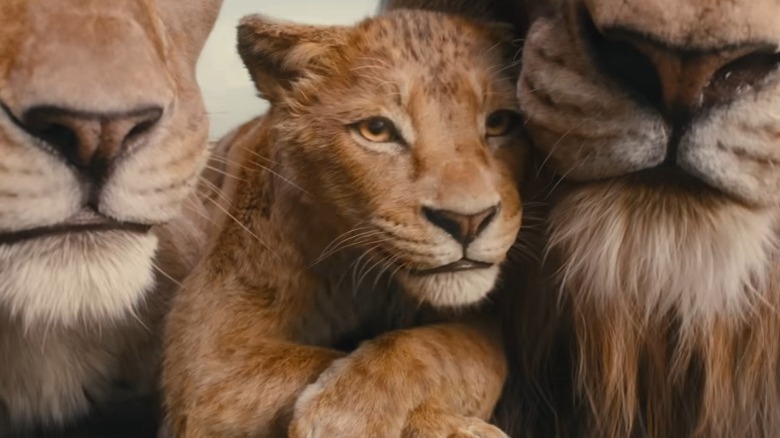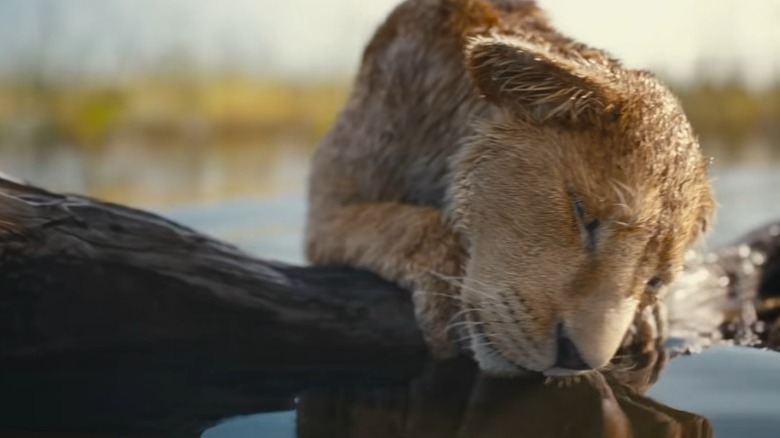Small Details You Missed In Mufasa: The Lion King
Contains spoilers for "Mufasa: The Lion King"
After five years, we've finally gotten an answer to the fascinating question of "Just what is renowned Academy Award-winning filmmaker Barry Jenkins up to with his photorealistic 'The Lion King' prequel?" As it turns out, the answer is, "A movie that fixes a lot of the problems with the original 2019 film and deepens the 'Lion King' mythos, while serving as a vehicle for Jenkins to explore a lot of his own interests as a director."
Scripted by Jeff Nathanson, "Mufasa: The Lion King" uses the same live-action-imitating technique as its predecessor, and acts as both a sequel and a prequel to it. While a framing story tells of how Simba (Donald Glover), Nala (Beyoncé), and the rest of the main characters get on with life after Simba's reinstatement as king of the Pride Lands, the film also shows us, as told by Rafiki (John Kani), the story of Simba's father Mufasa (Aaron Pierre). Over the course of 118 minutes, "Mufasa" details how the second most popular "Lion King" character was born into a small wandering pride, got separated from his parents, and ultimately found a brother and an inseparable best friend in Taka (Kelvin Harrison Jr.) — who would later become known as Scar.
If you've already seen "Mufasa," here are several little details of storytelling, filmmaking, world-building, and characterization that you may not have noticed.
A trailer shot turns out to be a lot less momentous in reality
In the first few minutes of "Mufasa," we watch Simba (Donald Glover) and Nala (Beyoncé) welcome their first child, Kiara. Then there's a time jump, and the film introduces its framing device: While Simba and Nala leave for an oasis to have their second child, Kiara (Blue Ivy Carter) stays in the Pride Lands and takes shelter in a cave while being cared for by Timon (Billy Eichner), Pumbaa (Seth Rogen), and Rafiki. Before Rafiki arrives, Timon and Pumbaa entertain Kiara with the story of how they supposedly fought and killed Scar (Chiwetel Ejiofor) — complete with a recreation of the climactic battle between Simba and Scar at the end of "The Lion King," but with the meerkat and the warthog subbing in for Simba.
You may or may not have paid attention to it while watching "Mufasa," but that throwaway comedic moment is actually a flagrant — and almost hilariously shameless — instance of trailer bait-and-switch. The shot of Timon and Pumbaa pushing a lion off a cliff while surrounded by flames appears in the trailer for "Mufasa," completely without context, from an angle that doesn't allow you to see who the lion is. It seemed to promise that Timon and Pumbaa would somehow not only be involved in the film's plot, but also in its action sequences. In a way, it's fitting for the characters that the actual nature of the shot in the final film would turn out to be a tall tale.
The cave where Kiara takes shelter is not the Pride Rock cave
The most iconic location and visual in "The Lion King" is undoubtedly Pride Rock, which serves as both a pulpit from which the Pride Lands' royal family can project their stature and authority and keep watch over the entire realm at once, and a cozy home for Mufasa and Sarabi and later Simba and Nala. Several of the film's key scenes — Rafiki introducing Simba to the world, Simba reclaiming his post as king — take place on the edge of the platform-like peak, and most of the domestic scenes involving Simba and his family are set inside the cave encrusted into the Rock.
This is true of both the original 1994 film and the 2019 remake, which, as you were watching "Mufasa," may have put you under the impression that the cave where Kiara and her caretakers shelter from the storm in the framing story is, indeed, the Pride Rock cave. Take a closer look, however, and you'll notice that it is not: As we can see in the shots that show the cave from the outside, it's merely another cave somewhere in the Pride Lands. Which makes a lot of sense — if the intent is to keep the royal child safe in Simba and Nala's absence, it's probably a better idea to hide her away somewhere less conspicuous than the official royal residence that sits right at the center of the kingdom.
The animals have much clearer facial expressions this time
The 2019 remake of "The Lion King" was a gigantic box office smash, but it was not exactly a hit with critics, and it did have its fair share of detractors even among casual viewers. One of the most common criticisms against the movie was that the characters looked so much like real-life animals that they lacked discernible facial expressions, making their emotions illegible; a fan even reimagined the "Lion King" characters with cartoony expressions. Still, that didn't stop it from becoming a rare "Rotten" movie that still made one billion at the box office.
For "Mufasa," whether because Barry Jenkins was artistically motivated to tackle that issue or because Disney opted for caution in making a film without the commercial safeguard of a near-identical original, the problem of animals' facial expressions was addressed. Departing from its stringent adherence to realistic animal behavior, the animation of "Mufasa" allows itself to express the characters' feelings through their faces — allowing, for instance, the lions to smile widely, knit their brows, and even contort their mouths in human-like surprise and panic. It's a relatively small and subtle change in terms of the film's overall look — you might not even have noticed it consciously, given that the environment animation and the character designs themselves remain largely naturalistic — but it contributes to making the story of Mufasa and Taka more personal, relatable, and emotionally affecting.
Taka is immediately curious about Mufasa as he approaches the river
"Mufasa" tells the story of how Mufasa overcomes his self-doubt to become a great leader and a king capable of uniting all the animals in the Pride Lands, but the character who goes through the most dramatic arc in the film is Taka. Although Taka's turn to evil is ostensibly prompted by the feeling of betrayal and heartbreak he gets upon learning of Mufasa and Sarabi's (Tiffany Boone) love for each other, the movie indicates that he actually had long-brewing, deep-buried feelings of resentment about Mufasa's presence in his life. He speaks to both Mufasa and Kiros (Mads Mikkelsen) as though rescuing Mufasa from the river and bringing him into his life had been a fortuitous, pivotal decision that he made for Mufasa's sake in the moment, and might as well not have made at all.
Look closely at Taka's introductory scene in the film, though: The very first glimpse we get of him shows that he's already got his eyes fully trained on Mufasa as he walks towards the river. Although Taka's trip to the river is intended as a water run, it's clear that Mufasa piques his curiosity immediately; he doesn't just catch Taka's eye as Taka is fetching water. In other words, there's some self-delusion to Taka's lifelong feeling that saving Mufasa was a self-defeating decision Mufasa duped him into. In truth, it was a very willful and deliberate choice on Taka's part.
Obasi's pride behaves more like a typical real-life lion pride
The very concept of a "lion king" as the patriarchal leader of his pride (and, by fantasy extension, of his whole land) is a bit of an iffy one, from a zoological standpoint. Although it is true that most prides have only one or few adult males, and that those males will often be primary progenitors and can be "usurped" by outsider males, lions' typical social structure is actually closer to what you might call a matriarchy. An average pride is made up of related lionesses and their offspring, with males usually leaving their pride upon reaching adulthood and then wandering from pride to pride over the years. Lionesses hunt and care for cubs; the social role of males, meanwhile, is usually limited to mating and pride defense, and they spend most of any given day sleeping and resting.
Save for the lion-lioness ratio in and of itself, you don't see much of that organization in Mufasa's pride in "The Lion King." "Mufasa," however, features a much more realistic pride in Obasi (Lennie James) and Eshe's (Thandiwe Newton) group, which indeed consists of lionesses as hunters while King Obasi mostly just sleeps — the movie even comically points out how little his role as "king" actually amounts to. Eshe's deference to Obasi on the matter of whether Mufasa can join the pride, however, is artistic license — in real life, lionesses are the ones who effectively lead the pride and determine which outsiders can join it.
It's not just trauma that makes Mufasa uncomfortable in water
An early, defining event in Mufasa's life is the river flood that sweeps him away before he's had the chance to learn to swim, and separates him from his parents Afia (Anika Noni Rose) and Masego (Keith David) despite their best efforts to rescue him. Following that trauma, Mufasa develops an immense fear of swimming, and of large water bodies in general, which shows up again and again throughout his life later on in the movie. It's one of the things that make him reluctant to follow Taka as he leaps onto the rocks scattered across a river to escape Kiros' pride: Mufasa is certain that they'll drown if they attempt to swim.
It's not just the trauma-generated fear that stops Mufasa on his tracks, though. There's another, subtler reason why he's so resistant to going into the water, in that scene as well as subsequent ones. The reason, of course, is that Mufasa's great survival skill lies in using the sounds, smells, and vibrations around him to take detailed stock of his environment. As carefully passed on to him by Eshe when she's teaching him to hunt, that perimeter-mapping ability is almost a superpower, which he repeatedly uses in times of duress. And it's much harder if not outright impossible for Mufasa to use it while swimming or floating in a river, where he's not really able to feel the Earth.
Taka's terror during the elephant stampede rhymes with what he later does to Mufasa
In the film's biggest and most exciting action set piece, Mufasa, Taka, Sarabi, Rafiki, and Zazu (Preston Nyman) find themselves trapped next to an elephant procession while Kiros' pride encroaches on them from the other side of a canyon. It's then that Sarabi has the idea to drop a beehive in the middle of the elephants to provoke them into a stampede. In the ensuing chaos, Sarabi gets knocked unconscious by an elephant and Mufasa drags her under a rock to keep her safe, while Rafiki climbs a tree and Zazu flies away.
Taka, meanwhile, finds himself stranded and alone in the middle of the stampede, and must hide underneath a rock to stay alive. He's visibly terrified as he watches the elephants run right above him, and even more when one of Kiros' goons pounces on him but gets crushed by an elephant. Upon closer inspection, the sheer panic on his face — and the fact that he watches Mufasa leap right by him without stopping — rings a bell. It's clearly a trauma that stayed with Taka, and it may well have had something to do with his decision to later kill Mufasa by gnu stampede (an element present in both versions of the original film, even though Mufasa's death is slightly different in the remake), as if to condemn his brother to feel a little bit of the horror he endured himself.
Taka's fearfulness isn't inherently bad, just frowned upon
One of the key components of Taka's character arc is his sense of guilt and shame over what he perceives as his own "cowardice" — i.e., his tendency to be fearful and evasive in the face of danger as opposed to proactively facing it head on. He particularly beats himself up for not jumping into action to protect his mother from Kiros' goons when they pounce on her and Mufasa, and instead running away — something his father heavily castigates him yet his mother forgives him for, telling him that his moment of courage will come.
Taka retains his tendency to be fearful and avoid direct brush-ups with danger throughout the movie, but, interestingly, it's later recontextualized as not inherently a bad thing. After all, being reluctant to fight and looking for alternatives can sometimes be useful. It saves both Taka and Mufasa when they're cornered by Kiros' pride on the edge of a waterfall — if it were up to Mufasa, they would have foolishly taken on the whole pride and inevitably been killed. The real problem plaguing Taka is not the fearfulness in itself, but the immense, crippling shame that he feels over it due to the pressure put on him by his father. Through that thematic wrinkle, in keeping with his previous work, Barry Jenkins once again tackles the concept of masculinity and the destructive, psychologically taxing expectations it places upon young men — or lions, in this case.
What makes Milele special is not the geography but the fauna
Early on in "Mufasa," Afia and Masego sing Mufasa a sweet, hopeful song about Milele, the supposed earthly paradise that they can one day reach if they persevere in getting across the desert. Mufasa spends the rest of his life dreaming of Milele, and eventually sets upon finding it with Rafiki's help. As promised by Mufasa's parents, Milele does, indeed, turn out to be a prosperous, abundant realm, full of water and grass and life: the Pride Lands.
Geographically speaking, however, the Pride Lands — especially as depicted in "Mufasa" — don't quite correspond with the magical, colorful, flower-strewn haven that Afia, Masego, and Mufasa dream of during the "Milele" musical number. They look more like a typical East African savanna: Beautiful and plentiful, but not unlike several other areas previously visited by the characters — including the very land Simba and Taka hail from, which also had rivers and wetlands and plenty of water availability. Ergo, what really makes Milele so exuberant is not so much the geography or the flora, but the presence of the myriad animal populations that have migrated to it from all over and made it a rich, bustling ecosystem. Given that most or all of the animals in "The Lion King" are anthropomorphized, there seems to be an interesting message in there about how what makes a place great isn't the place itself but its inhabitants, wherever they may hail from. Anywhere could be Milele.
The movie features plenty of classic Barry Jenkins close-ups
It's not all that shocking for Barry Jenkins to have chosen to tackle a remake, given that the director of "Moonlight" (one of the best movies by Black directors you should watch) has always been vocal about his love of artistically outreaching blockbusters: He previously had high praise for Ryan Coogler's handling of "Black Panther: Wakanda Forever." Indeed, although Jenkins' distinctive directorial style is somewhat hidden in "Mufasa" underneath all the Disney brand management and hyperdigital CGI wizardry, it's still very much there — particularly in his trademark penchant for head-on close-up shots.
Some directors would hesitate to employ that particular technique in a movie featuring no live-action actors, but, sure enough, Jenkins' directorial signature shows up in "Mufasa" as well, in the form of several clear, expressive, empathetic close-up shots of the characters, some of which are even idiosyncratically centered. You might not have taken notice of this visual choice, seeing as the faces being spotlighted aren't human this time around, but it shows up a number of times throughout the movie — including multiple shots that, if kept exactly the same with humans instead of CGI lions, wouldn't look out of place in "If Beale Street Could Talk" or on "The Underground Railroad." In addition to putting an unmistakable directorial stamp on the movie, it's a choice that speaks to Jenkins' trust in the animators to make the characters' faces more emotive this time around — there's a reason the 2019 "Lion King" had much fewer close-up shots.
Jenkins' penchant for water as a symbol of reckoning shows up too
The close-ups aren't the only recognizable Barry Jenkins touch in "Mufasa," either. Another Jenkins-esque motif that recurs throughout the movie are large bodies of water, and the protagonist's immersion into them. In "Mufasa," Mufasa plunges into water at two heavily symbolic points. First, during the flood that separates him from his parents, he finds himself deep underwater, and must gather the strength to swim to the surface, thus signaling he has become responsible for himself and his own life. Later, towards the end of the film, he fights Kiros in an underground lake and, after struggling against the elements, once again swims to the surface in a sequence that symbolizes his rebirth as a capable king and pride leader.
Both these sequences are highly evocative of the famous "Moonlight" scene in which Juan (Mahershala Ali) brings young Chiron (Alex Hibbert) into the sea and patiently teaches him to swim — a transformative moment that sees Chiron make his first tentative moves towards finding his place in the world and learning to fend for himself, while also showing him what it's like to be healthily loved and cared for by a parental figure. As a family-friendly Disney movie, "Mufasa" may not have quite the same depth and existential heft as "Moonlight," but it shows that Jenkins is still quite fond of an overwhelming mass of water and a poetic swimming scene as signifiers of existential reckoning.
